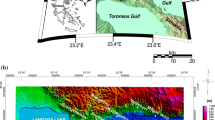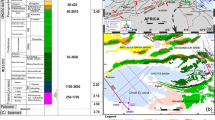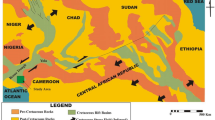Abstract
Despite several geological and geophysical studies that have focused on the estimation of the geometry of the sedimentary basins, the seismic documentation of sediment thickness is inadequately constrained due to the sparse spatial resolution of the expensive seismic and borehole measurements. To provide a new complementary insight into the morphology of the crystalline basement, I have re-examined the radially averaged power spectrum of magnetic anomalies for mapping depth to magnetic basement (DMB). DMB is a proxy of the non-magnetized sediment cover thickness over the magnetized crystalline basement. Synthetic models suggest that the accuracy of the method is not significantly influenced by the unknown magnetic fractal parameter and depth to the bottom of the magnetic slab. The windowing and window size effect on the estimated DMB can be substantial. Our synthetic tests suggest that the uncertainty of the calculated DMB increases with depth if the chosen window size is less than eight times the real DMB. I applied this method to the European, Greenland and North Atlantic regions because of the availability of seismically constrained sediment thickness or depth to the seismic basement (DSB), which allows comparison between DMB and DSB. The estimation of DMB was done by assuming a constant fractal parameter of three within a sliding window and with a variable size from 100 × 100 km in 10 km steps to a maximum size of 200 × 200 km until the estimated DMB is less than one eighth times of the window size. Comparison of DMB with DSB indicates a striking long-wavelength correlation along major sedimentary basins, while discrepancies may indicate limitations in the estimation methods for DMB and DSB.












Similar content being viewed by others
Data availability
The data and codes used in this study are available and can be provided by the corresponding author upon request.
References
Alavi, M. (1991). Sedimentary and structural characteristics of the Paleo-Tethys remnants in northeastern Iran. Geological Society of America Bulletin, 103, 983–992.
Artemieva, I. M. (2007). Dynamic topography of the East European craton: Shedding light upon lithospheric structure, composition and mantle dynamics. Global and Planetary Change, 58, 411–434. https://doi.org/10.1016/j.gloplacha.2007.02.013
Artemieva, I. M., & Thybo, H. (2008). Deep Norden: Highlights of the lithospheric structure of Northern Europe, Iceland, and Greenland. Episodes, 31, 98–106. https://doi.org/10.18814/epiiugs/2008/v31i1/014
Artemieva, I. M., & Thybo, H. (2013). EUNAseis: A seismic model for Moho and crustal structure in Europe, Greenland, and the North Atlantic region. Tectonophysics. https://doi.org/10.1016/j.tecto.2013.08.004
Ben-Avraham, Z., Ginzburg, A., Makris, J., & Eppelbaum, L. (2002). Crustal structure of the Levant Basin, eastern Mediterranean. Tectonophysics, 346, 23–43. https://doi.org/10.1016/S0040-1951(01)00226-8
Blakely, R. J. (1988). Curie temperature isotherm analysis and tectonic implications of aeromagnetic data from Nevada. Journal of Geophysical Research, 93, 11817. https://doi.org/10.1029/jb093ib10p11817
Blakely, R. J. (1995). Potential Theory in Gravity and Magnetic Applications. Cambridge: Cambridge University Press. https://doi.org/10.1017/CBO9780511549816
Bouligand, C., Glen, J. M. G., & Blakely, R. J. (2009). Mapping Curie temperature depth in the western United States with a fractal model for crustal magnetization. Journal of Geophysical Research, 114, 1–25. https://doi.org/10.1029/2009JB006494
Brückl, E., Behm, M., Decker, K., Grad, M., Guterch, A., Keller, G. R., & Thybo, H. (2010). Crustal structure and active tectonics in the Eastern Alps. Tectonics. https://doi.org/10.1029/2009TC002491
Brunet, F. F., Korotaev, M. V., Ershov, A. V., & Nikishin, A. M. (2003). The South Caspian Basin: A review of its evolution from subsidence modelling. Sedimentary Geology, 156, 119–148. https://doi.org/10.1016/S0037-0738(02)00285-3
Castellarin, A., & Cantelli, L. (2000). Neo-Alpine evolution of the Southern Eastern Alps. Journal of Geodynamics, 30, 251–274. https://doi.org/10.1016/S0264-3707(99)00036-8
Chakravarthi, V. (1995). Gravity interpretation of nonoutcropping sedimentary basins in which the density contrast decreases parabolically with depth. Pure and Applied Geophysics PAGEOPH, 145, 327.
Chakravarthi, V., & Sundararajan, N. (2005). Gravity modeling of 21/2-D sedimentary basins: A case of variable density contrast. Computers and Geosciences, 31, 820–827. https://doi.org/10.1016/j.cageo.2005.01.018
Chekunov, A. V., Garvish, V. K., Kutas, R. I., & Ryabchun, L. I. (1992). Dnieper-Donets palaeorift. Tectonophysics, 208, 257–272. https://doi.org/10.1016/0040-1951(92)90348-A
Clark, D. A., & Emerson, D. W. (1991). Notes on rock magnetization characteristics in applied geophysical studies. Exploration Geophysics, 22, 547–555. https://doi.org/10.1071/EG991547
Cloetingh, S., & Burov, E. (2011). Lithospheric folding and sedimentary basin evolution: A review and analysis of formation mechanisms. Basin Research, 23, 257–290. https://doi.org/10.1111/j.1365-2117.2010.00490.x
Cloetingh, S. A. P. L., Burov, E., Matenco, L., Toussaint, G., Bertotti, G., Andriessen, P. A. M., Wortel, M. J. R., & Spakman, W. (2004). Thermo-mechanical controls on the mode of continental collision in the SE Carpathians (Romania). Earth and Planetary Science Letters, 218, 57–76. https://doi.org/10.1016/S0012-821X(03)00645-9
Cooper, G. R. J., & Cowan, D. R. (2006). Enhancing potential field data using filters based on the local phase. Computers and Geosciences, 32, 1585–1591. https://doi.org/10.1016/J.CAGEO.2006.02.016
Coward, M., & Dietrich, D. (1989). Alpine tectonics: An overview. Geological Society Special Publication. https://doi.org/10.1144/GSL.SP.1989.045.01.01
Cowgill, E., Forte, A. M., Niemi, N., Avdeev, B., Tye, A., Trexler, C., Javakhishvili, Z., Elashvili, M., & Godoladze, T. (2016). Relict basin closure and crustal shortening budgets during continental collision: An example from Caucasus sediment provenance. Tectonics, 35, 2918–2947. https://doi.org/10.1002/2016TC004295
Deng, Y., Li, Z., Huang, S., Xu, Y., Hao, T., Bao, F., Zhang, S., Li, S., Jia, X., Tian, P., Zhang, S., Zang, N., & Zhang, W. (2023). Structure of the Gonghe Sedimentary Basin in the northeastern Tibetan Plateau: Evidence from teleseismic P waves recorded by a dense seismic array. Geophysical Journal International, 235, 1697–1711. https://doi.org/10.1093/gji/ggad327
Dercourt, J., Zonenshain, L. P., Ricou, L.-E., Kazmin, V. G., Le Pichon, X., Knipper, A. L., Grandjacquet, C., Sbortshikov, I. M., Geyssant, J., Lepvrier, C., Pechersky, D. H., Boulin, J., Sibuet, J.-C., Savostin, L. A., Sorokhtin, O., Westphal, M., Bazhenov, M. L., Lauer, J. P., & Biju-Duval, B. (1986). Geological evolution of the tethys belt from the atlantic to the pamirs since the LIAS. Tectonophysics, 123, 241–315. https://doi.org/10.1016/0040-1951(86)90199-X
Drachev, S. S., Malyshev, N. A., & Nikishin, A. M. (2010). Tectonic history and petroleum geology of the Russian Arctic Shelves: An overview. Petroleum Geology Conference Proceedings. https://doi.org/10.1144/0070591
Evenick, J. C. (2021). Glimpses into Earth’s history using a revised global sedimentary basin map. Earth-Science Reviews, 215, 103564. https://doi.org/10.1016/j.earscirev.2021.103564
Ewing, M., Worzel, J. L., Hersey, J. B., Press, F., & Hamilton, G. R. (1950). Seismic refraction measurements in the Atlantic Ocean Basin*. Bulletin of the Seismological Society of America, 40, 233–242. https://doi.org/10.1785/BSSA0400030233
Ferré, E. C., Kupenko, I., Martín-Hernández, F., Ravat, D., & Sanchez-Valle, C. (2021). Magnetic sources in the Earth’s mantle. Nature Reviews Earth and Environment, 2, 59–69. https://doi.org/10.1038/s43017-020-00107-x
Gorbatschev, R., & Bogdanova, S. (1993). Frontiers in the Baltic Shield. Precambrian Research, 64, 3–21. https://doi.org/10.1016/0301-9268(93)90066-B
Harris, F. J. (1978). On the use of windows for harmonic analysis with the discrete Fourier transform. Proceedings of the IEEE, 66, 51–83. https://doi.org/10.1109/proc.1978.10837
Hunt, C. P., Moskowitz, B. M., & Banerjee, S. K. (1995). Rock physics & phase relations: A handbook of physical constants. AGU Reference Shelf, 3, 189–204. https://doi.org/10.1029/RF003
Jackson, J., Priestley, K., Allen, M., & Berberian, M. (2002). Active tectonics of the South Caspian Basin. Geophysical Journal International, 148, 214–245. https://doi.org/10.1046/j.1365-246X.2002.01588.x
Kaiser, J.F. (1974). Nonrecursive digital filter design using the I_0-sinh window function. In Proceedings 1974 IEEE international symposium on circuits & systems, San Francisco DA, April. pp. 20–23.
Karner, G. D., Studinger, M., & Bell, R. E. (2005). Gravity anomalies of sedimentary basins and their mechanical implications: Application to the Ross Sea basins, West Antarctica. Earth and Planetary Science Letters, 235, 577–596. https://doi.org/10.1016/j.epsl.2005.04.016
Kelemework, Y., Fedi, M., & Milano, M. (2021). A review of spectral analysis of magnetic data for depth estimation. Geophysics, 86, J33–J58. https://doi.org/10.1190/geo2020-0268.1
Khain, V. E. (1975). Structure and main stages in the tectono-magmatic development of the Caucasus: an attempt at geodynamic interpretation. American Journal of Science, 275, 131–156.
Korhonen, J.K., Fairhead, J.D., Hamoudi, M., Hemant, K., Lesur, V., Mandea, M., Maus, S., Purucker, M.E., Ravat, D., Sazonova, T., Thébault, E. (2007). Magnetic Anomaly Map of the World – Carte des anomalies magnétiques du monde, Scale: 1:50,000,000l, 1st edn. Commission for the Geological Map of the World.
Kostyuchenko, S. L., Egorkin, A. V., & Solodilov, L. N. (1999). Structure and genetic mechanisms of the Precambrian rifts of the East-European Platform in Russian by integrated study of seismic, gravity, and magnetic data. Tectonophysics, 313, 9–28. https://doi.org/10.1016/S0040-1951(99)00187-0
Kumar, R., Bansal, A. R., Betts, P. G., & Ravat, D. (2021). Re-assessment of the depth to the base of magnetic sources (DBMS) in Australia from aeromagnetic data using the defractal method. Geophysical Journal International, 225, 530–547. https://doi.org/10.1093/gji/ggaa601
Lassen, A., & Thybo, H. (2012). Neoproterozoic and Palaeozoic evolution of SW Scandinavia based on integrated seismic interpretation. Precambrian Research, 204–205, 75–104. https://doi.org/10.1016/j.precamres.2012.01.008
Li, Y., & Oldenburg, D. W. (1993). 3-D inversion of magnetic data. 1993 SEG Annual Meet. Geophysics, 61, 400–402. https://doi.org/10.1190/1.1822498
Lindsley, D.H., Andreasen, G.E., Balsley, J.R., 1966. Section 25: Magnetic properties of rocks and minerals. pp. 543–552. https://doi.org/10.1130/MEM97-p543
Lordkipanidze, M. B., Meliksetian, B., & Djarbashian, R. (1989). Mesozoic-Cenozoic magmatic evolution of the Pontian–Crimean–Caucasian region. In M. Rakús, J. Dercourt, & A. E. M. Nairn (Eds.), Evol North margin Tethys results IGCP Proj (pp. 103–124). Paris: Mémoires de la Société Géologique.
Ludwig, W. J., Nafe, J. E., & Drake, C. L. (1970). Seismic refraction. In A. E. Maxwell (Ed.), The Sea (pp. 53–84). New York: Wiley-Interscience.
Mangino, S., & Preistley, K. (1998). The crustal structure of the South Caspian region. Geophysical Journal International, 133, 630–648.
Mangino, S., & Priestley, K. (1998). The crustal structure of the southern Caspian region. Geophysical Journal International, 133, 630–648. https://doi.org/10.1046/j.1365-246X.1998.00520.x
Mattavelli, L., Novelli, L., Anelli, L., (1991). Occurrence of hydrocarbons in the Adriatic Basin, Generation, accumulation, and production of Europe’s hydrocarbons.
Maus, S., Barckhausen, U., Berkenbosch, H., Bournas, N., Brozena, J., Childers, V., Dostaler, F., Fairhead, J. D., Finn, C., Von Frese, R. R. B., Gaina, C., Golynsky, S., Kucks, R., Lühr, H., Milligan, P., Mogren, S., Müller, R. D., Olesen, O., Pilkington, M., … Tontini, F. C. (2009a). EMAG2: A 2-arc min resolution Earth Magnetic Anomaly Grid compiled from satellite, airborne, and marine magnetic measurements. Geochemistry. Geophysics Geosystems, 10, 1–24. https://doi.org/10.1029/2009GC002471
Maus, S., & Dimri, V. (1995). Potential field power spectrum inversion for scaling geology. Journal of Geophysical Research. https://doi.org/10.1029/95JB00758
Maus, S., & Dimri, V. (1996). Depth estimation from the scaling power spectrum of potential fields? Geophysical Journal International, 124, 113–120. https://doi.org/10.1111/j.1365-246x.1996.tb06356.x
Maus, S., Gordon, D., & Fairhead, D. (1997). Curie-temperature depth estimation using a self-similar magnetization model. Geophysical Journal International, 129, 163–168. https://doi.org/10.1111/j.1365-246x.1997.tb00945.x
McKenzie, D. P. (1970). Plate tectonics of the Mediterranean Region. Nature, 226, 239–243. https://doi.org/10.1038/226239a0
McLean, M. A., Morand, V. J., & Cayley, R. A. (2010). Gravity and magnetic modelling of crustal structure in central Victoria: What lies under the Melbourne Zone? Australian Journal of Earth Sciences, 57, 153–173. https://doi.org/10.1080/08120090903416245
Mikołajczak, M., Mazur, S., & Gągała, Ł. (2019). Depth-to-basement for the East European Craton and Teisseyre-Tornquist Zone in Poland based on potential field data. International Journal of Earth Sciences, 108, 547–567. https://doi.org/10.1007/s00531-018-1668-9
Minshull, T. A., White, N. J., Edwards, R. A., Shillington, D. J., Scott, C. L., Demirer, A., Shaw-Champion, M., Jones, S. M., Erduran, M., Besevli, T., Price, A., & Peterson, B. (2005). Seismic data reveal eastern Black Sea Basin structure. Eos (washington. DC). https://doi.org/10.1029/2005EO430001
Mjelde, R., Faleide, J. I., Breivik, A. J., & Raum, T. (2009a). Lower crustal composition and crustal lineaments on the Vøring Margin, NE Atlantic: A review. Tectonophysics, 472, 183–193. https://doi.org/10.1016/j.tecto.2008.04.018
Mjelde, R., Raum, T., Kandilarov, A., Murai, Y., & Takanami, T. (2009b). Crustal structure and evolution of the outer Møre Margin, NE Atlantic. Tectonophysics, 468, 224–243. https://doi.org/10.1016/j.tecto.2008.06.003
Molinari, I., & Morelli, A. (2011). EPcrust: A reference crustal model for the European Plate. Geophysical Journal International, 185, 352–364. https://doi.org/10.1111/j.1365-246X.2011.04940.x
Nalivkin, V. D. (1976). Dynamics of the development of the russian platform structures. Tectonophysics, 36, 247–262. https://doi.org/10.1016/0040-1951(76)90019-6
Nance, R. D., Gutiérrez-Alonso, G., Keppie, J. D., Linnemann, U., Murphy, J. B., Quesada, C., Strachan, R. A., & Woodcock, N. H. (2010). Evolution of the Rheic Ocean. Gondwana Research, 17, 194–222. https://doi.org/10.1016/j.gr.2009.08.001
Nielsen, L., Boldreel, L. O., Hansen, T. M., Lykke-Andersen, H., Stemmerik, L., Surlyk, F., & Thybo, H. (2011). Integrated seismic analysis of the Chalk Group in eastern Denmark-Implications for estimates of maximum palaeo-burial in southwest Scandinavia. Tectonophysics, 511, 14–26. https://doi.org/10.1016/j.tecto.2011.08.010
Nikishin, A. M., Okay, A. I., Tüysüz, O., Demirer, A., Amelin, N., & Petrov, E. (2015b). The Black Sea basins structure and history: New model based on new deep penetration regional seismic data. Part 1: Basins structure and fill. Marine and Petroleum Geology, 59, 638–655. https://doi.org/10.1016/j.marpetgeo.2014.08.017
Nikishin, A. M., Okay, A., Tüysüz, O., Demirer, A., Wannier, M., Amelin, N., & Petrov, E. (2015a). The Black Sea basins structure and history: New model based on new deep penetration regional seismic data. Part 2: Tectonic history and paleogeography. Marine and Petroleum Geology, 59, 656–670. https://doi.org/10.1016/j.marpetgeo.2014.08.018
Okay, A. I., & Topuz, G. (2017). Variscan orogeny in the Black Sea region. International Journal of Earth Sciences, 106, 569–592. https://doi.org/10.1007/s00531-016-1395-z
Okay, A.I., n.d. Geology of Turkey: A Synopsis. Small 19–42.
Pajang, S., Cubas, N., Letouzey, J., Le Pourhiet, L., Seyedali, S., Fournier, M., Agard, P., Khatib, M. M., Heyhat, M., & Mokhtari, M. (2021). Seismic hazard of the western Makran subduction zone: Insight from mechanical modelling and inferred frictional properties. Earth and Planetary Science Letters, 562, 116789. https://doi.org/10.1016/j.epsl.2021.116789
Richards, J. P. (2015). Tectonic, magmatic, and metallogenic evolution of the Tethyan orogen: From subduction to collision. Ore Geology Reviews, 70, 323–345. https://doi.org/10.1016/J.OREGEOREV.2014.11.009
Ritzmann, O., Maercklin, N., Inge Faleide, J., Bungum, H., Mooney, W. D., & Detweiler, S. T. (2007). A three-dimensional geophysical model of the crust in the Barents Sea region: Model construction and basement characterization. Geophysical Journal International, 170, 417–435. https://doi.org/10.1111/j.1365-246X.2007.03337.x
Ross, H. E., Blakely, R. J., & Zoback, M. D. (2006). Testing the use of aeromagnetic data for the determination of Curie depth in California. Geophysics, 71, L51–L59. https://doi.org/10.1190/1.2335572
Şengör, A. M. C., Lom, N., Sunal, G., Zabcı, C., & Sancar, T. (2019). The phanerozoic palaeotectonics of Turkey. Part I: An inventory. Mediterranean Geoscience Reviews, 1, 91–161. https://doi.org/10.1007/s42990-019-00007-3
Shuey, R. T., Schellinger, D. K., Tripp, A. C., & Alley, L. B. (1977). Curie depth determination from aeromagnetic spectra. Geophysical Journal International, 50, 75–101. https://doi.org/10.1111/j.1365-246x.1977.tb01325.x
Silva, J. B. C., Costa, D. C. L., & Barbosa, V. C. F. (2006). Gravity inversion of basement relief and estimation of density contrast variation with depth. Geophysics, 71, J51–J58. https://doi.org/10.1190/1.2236383
Stampfli, G. M., Borel, G. D., Cavazza, W., Mosar, J., & Ziegler, P. A. (2001). Palaeotectonic and palaeogeographic evolution of the western Tethys and PeriTethyan domain (IGCP Project 369). Episodes, 24, 222–228. https://doi.org/10.18814/epiiugs/2001/v24i4/001
Tanaka, A., Okubo, Y., & Matsubayashi, O. (1999). Curie point depth based on spectrum analysis of the magnetic anomaly data in East and Southeast Asia. Tectonophysics, 306, 461–470. https://doi.org/10.1016/s0040-1951(99)00072-4
Teknik, V., Artemieva, I. M., & Thybo, H. (2023). Geodynamics of the Central Tethyan Belt Revisited: Inferences from crustal magnetization in the Anatolia-Caucasus-Black Sea Region. Tectonics. https://doi.org/10.1029/2022TC007282
Teknik, V., & Ghods, A. (2017). Depth of magnetic basement in Iran based on fractal spectral analysis of aeromagnetic data. Geophysical Journal International, 209, 1878–1891. https://doi.org/10.1093/gji/ggx132
Teknik, V., Ghods, A., Thybo, H., & Artemieva, I. M. (2019). Crustal density structure of the northwestern Iranian Plateau. Canadian Journal of Earth Sciences, 56, 1347–1365. https://doi.org/10.1139/cjes-2018-0232
Teknik, V., Thybo, H., Artemieva, I. M., & Ghods, A. (2020). A new tectonic map of the Iranian plateau based on aeromagnetic identification of magmatic arcs and ophiolite belts. Tectonophysics in Review. https://doi.org/10.1016/j.tecto.2020.228588
Telford, W. M., Geldart, L. P., & Sheriff, R. E. (1991). Applied Geophysics (2nd edition) by. Cambridge University Press.
Thybo, H., & Artemieva, I. M. (2020). Trans-European Suture Zone. Encyclopedia of Earth Sciences Series. https://doi.org/10.1007/978-3-030-10475-7_282-1
Toft, P. B., Arkani-Hamed, J., & Haggerty, S. E. (1990). The effects of serpentinization on density and magnetic susceptibility: A petrophysical model. Physics of the Earth and Planetary Interiors, 65, 137–157. https://doi.org/10.1016/0031-9201(90)90082-9
Zonenshain, L. P., & Pichon, X. (1986). Deep basins of the Black Sea and Caspian Sea as remnants of Mesozoic back-arc basins. Tectonophysics, 123, 181–211. https://doi.org/10.1016/0040-1951(86)90197-6
Acknowledgements
This work was carried out at Istanbul Technical University-Eurasia Institute of Earth Science. VT is financed by a grant from the Tubitak programme (Project #120C144 titled “Formation and Evolution of the Anatolian Lithosphere based on Geophysical Data”). VT thanks Irina Artemieva and Hans Thybo for helpful comments and discussions. Finally, I would like to thank Dr. Tuna Eken, editor of Pure and Applied Geophysics, and two anonymous reviewers for their constructive and helpful comments, which have significantly improved the quality and clarity of our manuscript.
Funding
The author has received research support from TÜBİTAK (Turkey) (Grant numbers [#120C144]).
Author information
Authors and Affiliations
Contributions
V.T prepared figures, wrote the main manuscript text, and reviewed the manuscript.
Corresponding author
Ethics declarations
Conflict of interest
The authors have no relevant financial or non-financial interests to disclose.
Additional information
Publisher's Note
Springer Nature remains neutral with regard to jurisdictional claims in published maps and institutional affiliations.
Supplementary Information
Below is the link to the electronic supplementary material.
Rights and permissions
Springer Nature or its licensor (e.g. a society or other partner) holds exclusive rights to this article under a publishing agreement with the author(s) or other rightsholder(s); author self-archiving of the accepted manuscript version of this article is solely governed by the terms of such publishing agreement and applicable law.
About this article
Cite this article
Teknik, V. Estimation of the Depth to the Magnetic Basement in Europe Using the Spectral Method. Pure Appl. Geophys. (2024). https://doi.org/10.1007/s00024-024-03459-3
Received:
Revised:
Accepted:
Published:
DOI: https://doi.org/10.1007/s00024-024-03459-3




